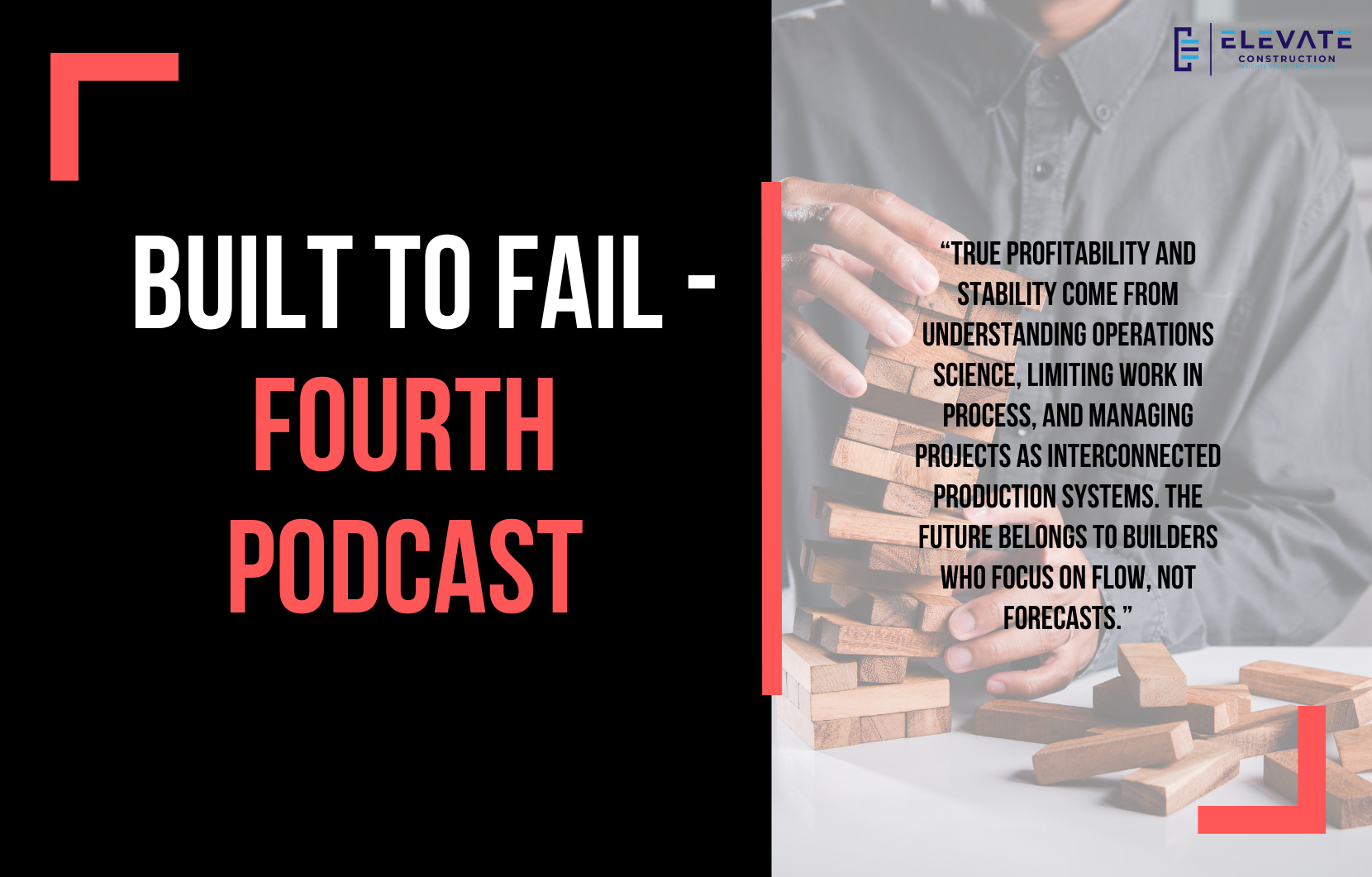If Not Administration, Then What? The Era of Profitability through Production
In this blog, we continue exploring Built to Fail by Todd Zabel a book that challenges how we think about construction, productivity, and project management. Chapter 4 asks a powerful question:
“If not administration, then what?”
This chapter introduces the era of profitability by making production the focus. It’s not just about money it’s about the relationship between production and profitability. When we improve production, we naturally improve profitability.
Projects Are Production Systems
Zabel argues that projects are an assemblage of multiple production systems that together yield a product or result and therefore, should be managed as such, using operations science to understand and influence their behavior.
That means construction isn’t about paperwork or progress reports it’s about how things are designed, made, transported, and built.
A production system includes processes, operations, resources, control mechanisms, and key performance indicators (KPIs) that take inputs and create outputs. When we understand those systems, we can actually manage and improve the work.
Unfortunately, the traditional Project Management Institute (PMI) doctrine and by extension, the PMP certification focuses on administration, not production. It measures but doesn’t manage. It forecasts but doesn’t build.
What’s Wrong With How We Manage Projects
In Eras 1 and 2, the industry’s dominant tools bar charts, Gantt charts, CPM schedules simply describe what we want to happen, not what can actually happen based on available resources.
That’s the critical difference between prediction and production.
For example, Takt plans are powerful because they represent what’s possible given the actual capacity and constraints within a system not an idealized version of what a client hopes for.
Understanding Production Through Operations Science
Zabel introduces the 4-5-3 Framework, which helps us define and manage production systems:
The 4 Verbs:
- Design: how we design things
- Make: how we make things
- Transport: how we move things
- Build: how we assemble things
The 5 Levers:
- Product design
- Process design
- Available capacity
- Inventory (work in process)
- Variability
By optimizing these, we can dramatically improve production flow and project performance.
However, the industry often confuses business process maps for production flow diagrams. We are still blind to production, as the Lean Construction Institute has pointed out focusing on processes that look good in reports rather than those that improve the work itself.
The Three Curves That Explain Everything
Zabel also highlights three mathematical curves that define how production systems behave. Understanding these is key to optimizing flow:
- Cycle Time vs. Utilization
- The more you increase utilization the busier everyone is the longer the overall cycle time becomes.
- Like traffic on a highway, the more cars you add, the slower everyone moves.
- Throughput vs. Work in Process (WIP)
- You can only push so much work through a system before it plateaus at its bottleneck.
- No matter how fast the upstream work goes, the bottleneck dictates the pace.
- Cycle Time vs. Work in Process (WIP)
- The more WIP in your system, the longer everything takes.
- Rushing and overloading crews leads to congestion, not progress.
In short, more work doesn’t mean faster results it means longer durations and higher costs.
The Industry’s Blind Spot
Eras 1 and 2 failed because they ignored operations science. The construction industry still pushes for high utilization and heavy WIP believing busier equals better when, in fact, it just creates congestion.
As Zabel points out, PMI itself admits that operations management is considered separate from project management. That’s a massive blind spot.
This mindset has led to systems like Earned Value Management (EVM), which encourage spending and busyness, not progress. Projects end up costing more, taking longer, and tying up more resources all in the name of “tracking performance.”
The Real Cost of Ignoring Flow
When projects overemphasize utilization and work in process:
- Labor, equipment, and space are wasted.
- Cash flow is tied up in excessive materials and work fronts.
- Obsolescence increases when design changes make early work irrelevant.
- Delays multiply because the system is overloaded.
In other words, the harder you push, the slower you go.
The key is finding balance maintaining just enough work in process to sustain throughput without causing congestion.
Summary
Here’s what this chapter teaches us:
- Projects are production systems, not administrative exercises.
- We must design and manage these systems by focusing on how we design, make, transport, and build.
- Use the five levers design, process, capacity, inventory, and variability to optimize flow.
- Understand the three curves utilization, throughput, and WIP to predict real outcomes.
- Stop rushing, pushing, and panicking. High utilization and excessive WIP extend durations, not shorten them.
- Abandon administrative illusions like EVM and CPM; they predict but don’t produce.
The path forward is clear: study operations science, build stable production systems, and measure what truly matters flow and reliability.
Key Takeaway
The construction industry has spent decades perfecting administration instead of production. True profitability and stability come from understanding operations science, limiting work in process, and managing projects as interconnected production systems. The future belongs to builders who focus on flow, not forecasts.
If you want to learn more we have:
-Takt Virtual Training: (Click here)
-Check out our Youtube channel for more info: (Click here)
-Listen to the Elevate Construction podcast: (Click here)
-Check out our training programs and certifications: (Click here)
-The Takt Book: (Click here)
Discover Jason’s Expertise:
Meet Jason Schroeder, the driving force behind Elevate Construction IST. As the company’s owner and principal consultant, he’s dedicated to taking construction to new heights. With a wealth of industry experience, he’s crafted the Field Engineer Boot Camp and Superintendent Boot Camp – intensive training programs engineered to cultivate top-tier leaders capable of steering their teams towards success. Jason’s vision? To expand his training initiatives across the nation, empowering construction firms to soar to unprecedented levels of excellence.
On we go

